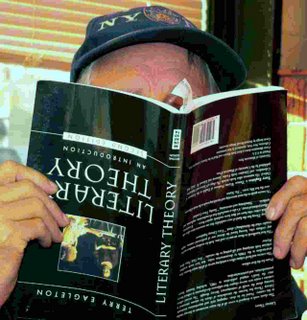Skimming through what Canadian poet David Solway wrote in 1989 about education (ISBN: 0-7744-0330-6), I was picking up bits and pieces about every theory of education right and left going back to Aristotle. It keeps striking me that Solway is on the opposite side compared to Canadian poet Dennis Lee, at least as far as their role and perspectives vis a vis the 1960s is concerned. (We will return to Lee's work on CPE.)
If the rest of Cheap Priceless Editionstill the end of time were but a footnote to Solway versus Lee I think it could still be very interesting and enriching (at least intellectually for me, certainly not financially, and for the readers . . well enough said). Then I would entitle the blog The Hippie versus The Educator: Spurious Time-Frames.
Let's keep that thought, as idiots say, and jump into a Baudelaire poem referenced by Solway as a text 'over analysed' by two heavy academic structuralists.
Solway doesn't say this, but the poem was always free of the shackles of the academics, so why worry? When, however, you stick with your studies and learn, as Solway would have the world turn, you could argue that, after the structuralists did their exigesis, postmodernists broke the bounderies of interpretation of language and liberated Baudelaire to scan freely.
A Link to the Prose at the end, not to the Poem
English translation and French original: Charles Baudelaire (1857)
Baudelaire does not look happy as scholars dissect his poem.
The Cats
Fervent lovers and austere scholars
Both love equally, in their mature season,
Powerful and gentle cats, the pride of the household,
Who, like the former, are easily chilled and, like the latter, sedentary.
Friends of science and fleshly delights,
They seek silence and the horror of the shadows;
Erebus would have made them his funereal chargers,
If they could have bowed their pride to servitude.
When dreaming they strike the noble poses
Of great sphinxes stretched out in the depths of solitude,
Who seem to slumber in a dream without end;
Their fecund loins are full of magical sparks,
And bits of gold, like a fine sand,
Sparkle faintly like stars in their mystical eyes.
-------------------
LES CHATS
Les amoureux fervents et les savants austères
Aiment également, dans leur mûre saison,
Les chats puissants et doux, orgueil de la maison,
Qui comme eux sont frileux et comme eux sédentaires.
Amis de la science et de la volupté,
Ils cherchent le silence et l'horreur des ténèbres;
L'Èrèbe les eût pris pour ses coursiers funèbres,
S'ils pouvaient au servage incliner leur fierté.
Ils prennent en songeant les nobles attitudes
Des grands sphinx allongés au fond des solitudes,
Qui semblent s'endormir dans un rêve sans fin;
Leurs reins féconds sont pleins d'étincelles magiques,
Et des parcelles d'or, ainsi qu'un sable fin,
Ètoilent vaguement leurs prunelles mystiques.
RADI SURDULESCU
Lévi-Strauss and Jakobson’s close analysis of Les chats emphasizes the value of the text as an “absolute object”: this value is due to the complex modulations of its units, be they syntactic, rhetorical or, especially, phonic. [3] In a polemical response to the study of Les chats, [4] the American critic Michael Riffaterre called in question the validity of its authors’ approach, which is based on the delineation of four structures within the sonnet:
1. a tripartite division (quatrain I, quatrain II, sestet), defined by grammatical and metric models;
2. a bipartite division (octet vs. sestet);
3. a chiasma-like division, relating quatrain I to tercet II, and quatrain II to tercet I (in which the cats appear as objects and, respectively, subjects);
4. a system which envisages the sonnet as an open structure, made up of two sestets, separated by a distich.
Riffaterre does not belie the existence of these structures and interplays, but in the chapter “The Irrelevance of Grammar” of his essay he questions their equal contribution to the poetry of the text: not all linguistic symmetries are literarily active in the poem, as a purely “technical” reading may suggest.
Therefore the receiver of the poetic message should also be taken into account, and in that sense Riffaterre coins the term ”superreader”, denoting a fictitious person who should have the advantage of “screening pertinent structures and only pertinent structures”. (38) Riffaterre mentions that the “superreader” in this particular case is composed of:
Baudelaire himself
commentators of the poem, including Jakobson and Lévi-Strauss (when they “deviate from the method”)
a Larousse dictionary, other notes and other informants, and so forth . .
. . thereby he departs from pure structuralism in so far as he takes into consideration also the historical context of the work, and the response of his sensitive reader. However, his celebrated critique of Jakobson’s method is not lacking in arguments: “no grammatical analysis of a poem can give us more than the grammar of the poem”, he contends, and an evenhanded search for contrasts and parallelisms leads nowhere, while it betrays a mere “belief in the intrinsic explanatory worth of purely descriptive terms”.
Looking at structuralism in retrospect, whether in the interpretation of poetry, or in the study of narratives, or in the description of texts in general and of other cultural products, one cannot help observing how far it is, though not very remote in time, from the present-day skepticism towards anything stable and central in whatever kind of textual structure. In a postmodern “quantum universe”, as some thinkers define the contemporary world, a single determinate meaning appears to be impossible to attain, and the binary opposite, with the alleged identity of, and the absolute difference between, terms, is no longer a valid instrument for defining cultural reality, as hard-core structuralists would firmly believe.
Instead, the unstable, self-subverting structures of our post-Einsteinean reality are best described by concepts such as relativity, uncertainty, or discontinuity: the following chapter will deal precisely with this rupture in the evolution of the traditional logic of determinate binary structures.
From RADI SURDULESCU, Form, Structure, and Structuality in Critical Theory
price-compare results for meta vendor sites
25 November 2006
Subscribe to:
Post Comments (Atom)



No comments:
Post a Comment